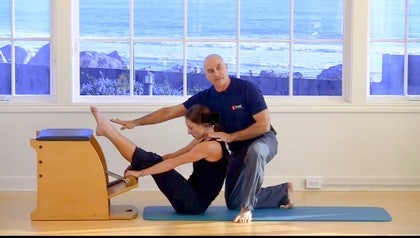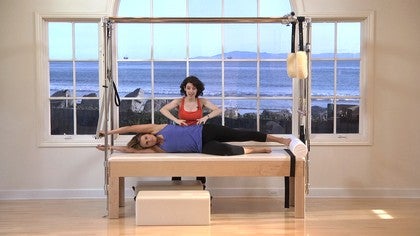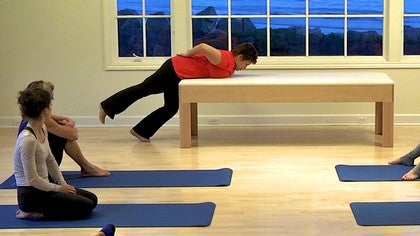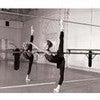Description
About This Video
Transcript
Read Full Transcript
Oh, this little segment I want to show you here is how to help the body understand spinal extension. Sometimes with your clients, when they do a swan, either in quadro pet or they're doing a pushup with their arms, they kind of tend to feel it in their low back and some people say, how do I get out of my low back? How do I do that? What's the key? Is it pulling the belly in more? Is it tucking the bottom? All those kinds of things. Well, I'm going to tell you what often happens when people get into their low back. It's partly because their hips are tight. So what I'm going to do is I'm going to teach you a little something on how to get out of your hips before you even start the exercise. It looks like this.
You use the edge of your Cadillac, okay? You Bend your knees, you're going to put the edge of your pelvis right on the table. You're going to lie yourself down. You can rest your head on your hands. You can bend your knees and you're letting the weight of your hips kind of dropped down. So you'll notice right now that my back is roughly level, depending on the size of somebody's chest, it, you know, they may be up or down or something like that. So this is just roughly about level here. So as I look at my back, there's a natural curve that that happens in the back that, but, but my booty is not sticking way up.
If somebody has really hip flexor tightness, their, their bottom tends to stick behind them. So by resting down, I'm giving their hip flection. Do you see I'm in hip flection now I'm giving you this position. Remember, sometimes we have to give people their position of their own dysfunction to help them feel something else a little bit more, um, successfully. So from here I'm going to just take my right leg out, am going a place, one of my hands. I'm gonna place my right hand behind my back here so that as I engage and lift my leg up, I'm going to monitor if I'm doing this, can can you see the difference between lifting my leg and arching my back versus engaging my belly and my pelvic floor and lifting my leg. You should see much more glute activity in hamstring activity here and then lowering down.
So I'm not necessarily tucking my bottom into the table. I'm not using a tuck as a false sense of strength. Okay. I'm just allowing my pelvis to stay flat and I'm going to lift my left leg up. So I'm going to take my left leg out. How far I lift. It doesn't matter. Some people can only lift it here and then they let their core go and then they end up doing that in their low back fella. So now I'm going to take my leg out, pull my tummy in, stretch long. So right now my leg is not even level.
Okay? Because maybe that's all my hip flection can afford. Okay. So if my hip flection, if my hip flexors, excuse me, can let go to allow me to lift my leg higher without getting into my back, then that's great. So the challenges then to lift the hip flexors, the next level from here looks like this. I don't particularly have tight hip flexors, but if I did it would look something like this. Okay. That's a little accident waiting to happen. So we want to avoid that. So maybe I have to go back to this and just lift this length so I get strength in the back. And believe it or not, this is a dynamic stretch for the front of the hip. Okay.
Which is the exercise single leg kick in in the mat work. Okay. So we may need to do single leg kick actually flat without being propped up because that may not be a good choice for a person who gets into their back. So now to build extension from the top, I'm going to stay in this position. This is like flight right on the map, but I've just taken my legs out of it.
I pull my shoulder blades towards my spine, engage my triceps, lift my pelvic floor, and then I lift my shoulder blades and I shoot out like a rocket to arch my thoracic spine. And then when I lie down, I don't just drop down, but I segmental [inaudible] lie myself back down. When you go all through the trouble of learning segmental ization supine, take the time to learn it prone as well. So arms lift. Where did we already learn it? Quadruples this is just me doing quadruples, right? This is just me doing quadruple right here, but my legs are over the edge of the table. Now I can turn this exercise now into swan on the long box. Squeeze my heels together, arms down by my side. Press away.
I'm not going to move the table. Press away the arms, lift up the thighs, engage. I open up the heart length and myself back out and then lower myself down. I can do breast stroke here, right here comes my straps in the side of the reformer. I push out the straps, I let the straps pull me back and open the chest and then lengthen back out and then bend my knees, my elbows in all that without overworking my low back because I've given myself some support against here on the reformer, you have the long box that you can press into, but it's teaching your body how to support from your hips and your pelvis to allow the spinal extension to happen. We know that if people have tight hips, that's classic tight hips, they tend to sit back in their buttock. So how do people stretch their hip?
They just do this. That's really not going to work. Okay, so the other thing I want to show you here, it looks like this. I'm going to take my leg on the edge of the Cadillac and just lie myself down. The Cadillac or the bed allows a flat surface so that when I bend this knee, it doesn't do this. Do you see the difference? So maybe as a teacher you need to support or or help somebody here so that maybe they only been there need to hear. So maybe they're single leg kick exercise only looks like this because if they go too far, it might look like this. I mean, we say to them, don't rock your pelvis. Don't move side to side.
But we don't give a strategy to help not do that. So you have to make the range of motion just a little bit less. Make the connection a little bit more through the thighs. Maybe the spinal extension part of that exercise needs to be left out initially because maybe if somebody has too much driven in spinal extension, they rest a little bit too much. Okay. So hopefully some of those tidbits will kind of help you practice some things to get out of the low back when you teach the legs how to behave. I say.
Back Care: Workouts and Tips for a Healthy Spine
Comments

You need to be a subscriber to post a comment.
Please Log In or Create an Account to start your free trial.




































